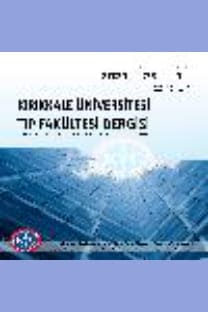FONKSİYONEL ENDOSKOPİK SİNÜS CERRAHİSİ HİSTOPATOLOJİ SONUÇLARIMIZ
Dağılım fonksiyonel endoskopik sinüs cerrahisi, histopatoloji, nazal polip, rinosinüzit
Histopathological Results of Functional Endoscopic Sinus Surgery
Distribution functional endoscopic sinus surgery, hispathology, nasal polyp, rhinosinusitis,
___
- Garça MF, Çelik Ö, Gültekin E, Külekçi M. Fonksiyonel endoskopik sinüs cerrahisi sonuçlarımız. Tıp Araştırmaları Dergisi. 2010; 8: 89-93.
- Karakus MF, Ozcan KM, Ozcan M, Yuksel Y, Titiz A, Unal A. Changes in indications for endoscopic sinonasal surgery over 14 years. B-ENT. 2008 4: 221-5.
- Stammberger H. Surgical treatment of nasal polyps: past, present, and future. Allergy. 1999; 54(s53): 7- 11.
- Erkan AN, Tarhan E, Yilmazer C, Cagici A, Cakmak O. Endoscopic removal of sinonasal tumors. Kulak Burun Bogaz Ihtis Derg. 2006; 16: 72-9.
- Karcı B. Burun ve Paranazal Sinüs Tümörleri. Burun ve Sinüsler. In: Can Koç Kulak Burun Boğaz Hastalıkları ve Baş Boyun Cerrahisi, 3. baskı, Ankara: Güneş Tıp Kitabevi. 2004: 745-69
- Fahmy F, Back G, Smith T, Hosnl A. Osseous haemangioma of inferior turbinate. The Journal of Laryngology & Otology. 2001; 115: 417-8.
- Fu YS, Perzin KH. Non-epithelial tumours of the nasal cavity, paranasal sinuses and nasopharynx: Aclinicopathological study. Cancer1974; 33: 1275- 88.
- Bublik M, Herman B, Younis R. Functional endoscopic sinüs surgery. Operative Technique Otolaryngol. 2009; 20: 167-71.
- Lal D, Stankiewicz JA. Primary sinus surgery. In: Flint PW, Haughey BH, Lund LJ, editors. Cummings Otolaryngology: Head and Neck Surgery. 5th ed. Philadelphia: Elsevier Mosby. 2010: 739-58.
- Newton JR, Ah-See KW. A review of nasal polyposis. Ther Clin Risk Manag. 2008; 4: 507-12.
- Lund V. Introduction. Allergy 1999; 54: 5-6.
- Hosemann W, Göde U, Wagner W. Epidemiology, pathophysiology of nasal polyposis and spectrum of endonasal sinus surgery. Am J Otolaryngol. 1994; 15: 85-98.
- Kodama S, Yoshida K, Nomi N, Fujita K, Suzuki M. Successful treatment of nasal septum hemangioma with the Harmonic Scalpel: a case report. Auris Nasus Larynx. 2006; 33(4): 475-8.
- Çaylakli F, Çagici AC, Hürcan C, Bal N, Kizilkiliç O, Kiroglu F. MD Cavernous hemangioma of the middle turbinate: A case report Ear Nose Throat J. 2008; 87(7): 391-3
- Lazar CC, Costentin B, François A, Marie JP, Dehesdin D. Bleeding polyp of the nasal septum: an uncommon lesion in adults. Ann Otol Rhinol Laryngol. 2004; 113(8): 652-4.
- ISSN: 2148-9645
- Yayın Aralığı: Yılda 3 Sayı
- Başlangıç: 1999
- Yayıncı: KIRIKKALE ÜNİVERSİTESİ KÜTÜPHANE VE DOKÜMANTASYON BAŞKANLIĞI
FONKSİYONEL ENDOSKOPİK SİNÜS CERRAHİSİ HİSTOPATOLOJİ SONUÇLARIMIZ
Hatice AKAY GÜZELKÜÇÜK, GÖKÇE ŞİMŞEK, Rahmi KILIÇ
Nadir Bir Refleks Epilepsi Türü: Sıcak Su Epilepsisi
ÖZGÜR TATLI, Selim YURTSEVER, MÜCAHİT GÜNAYDIN, Faruk ÖZŞAHİN, Gürkan ALTUNKAŞ, Nurhak AKSÜT
GENÇ ERİŞKİN HASTADA SEKONDER MİDGUT VOLVULUS:OLGU SUNUMU
Erdal DEMİRTAŞ, Bülent DEMİR, Soykan TOPÇU, Esin DEMİRTAŞ, YUSUF KENAN TEKİN
Süheyla KANDEMİR, GÖKÇE ŞİMŞEK, Bengi MELİKOĞLU, Mahi BALCI, NURAY BAYAR MULUK, Rahmi KILIÇ
SAĞLIK ÇALIŞANLARININ TÜKENMİŞLİK, İŞ DOYUMU DÜZEYLERİ VE YAŞAM DOYUMUNUN İNCELENMESİ
ÖZLEM TEKİR, CELALETTİN ÇEVİK, Selma ARIK, Gözde CEYLAN
SEPTOPLASTİ SONRASI RETİNAL ARTER DAL OKLÜZYONU
Mesut TOZAR, Süheyla KANDEMİR, GÖKÇE ŞİMŞEK, ZAFER ONARAN, Rahmi KILIÇ
Elnare GÜNAL, Hayri RAMADAN, Ali BİLGİN, HANDAN ÇİFTÇİ, FİGEN ÇOŞKUN
RESVERATROL, PALMİTAT İLE İNDÜKLENEN ENDOPLAZMİK RETİKULUM STRESİ İNHİBE EDER: ANTİ-APOPTOTİK ETKİ
Asli F. CEYLAN, SİNEM ASLAN ERDEM
SODYUM GLUKOZ KO-TRANSPORTER 2 İNHİBİTÖRLERİNİN PLEİOTROPİK ETKİLERİ
